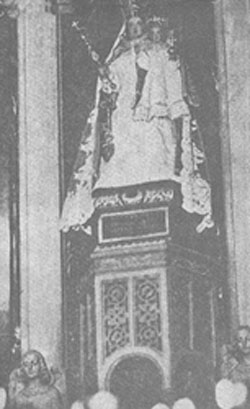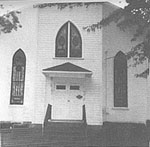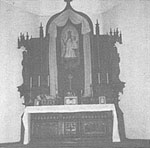|
flight from conscription into the Turkish army -- so also were the life stories of the immigrants similar. Hard work, deep religious commitments, respect for law and order, and a love for the new country were the watch�-words of their lives. The women, as homemakers laid the foundations for the lives of their American children. The Story of Rose Joesph A life long resident of Cleveland, Mrs. Abdallah Joseph says: My father's name was Abdallah Yousef Aftoora, and my mother was Asma Khalil Geha. My father was a cobbler in Zahle in the Lebanon, and he had a good business, but he was young and adventurous, and he heard that the people who went to Australia and South America were becoming very rich, and so he thought, 'Well, I will go, and see what I can do.' Then his plans changed and he decided to come to America. First he would leave my mother and the children behind and he would come over here, work, and send for the family. But my mother was young and adventurous too, and she said, 'No, if my husband goes, I will go with him.' So they left my two older sisters with our grandmother, and they brought me, an infant in my mother's arms, to Cleveland. It was 1892 when we set sail. In a little while, my parents began to miss my sisters very much, but trips back and forth were not easy then. Finally after three years in America, we returned to Zahle. Then it was another five years before we came back again. This time, in 1900, my parents brought us three daughters and came to Cleveland to establish a new home. Rose Joseph recalled that there was a Mr. Najeeb Zlaket who had a big job at the Workhouse and that other people also began to get jobs with the city and with the county. That was considered a real advancement in those days, particularly since Syrians and Lebanese in their own country
were limited to minimal participation in the administration of their own towns and villages. Only the most influential and wealthiest were selected by the Ottomans to represent their people in the millet governments established by the Turks. Therefore, it was a stimulating experience to be an employee of the government in America. As a small girl, Mrs. Joseph was sent to old Eagle school, then to Brownell, and to St. John's Cathedral School where she studied for First Communion. She was a familiar visitor to St. John's and to the Bishop's office. "I remember," she said, "that my father and our priest would take me with them to Bishop Horstmann so that I could interpret for them while they discussed plans for a new church for our people. I never could understand why," she laughed, "because they would only be there a few minutes before they all started jabbering in French, and there I was, bored to death, not understanding anything they were saying. Each time they went, I would say to my father, "You don't need me to go along, but he would say, 'Never mind, you come.' I don't think I was ever much use to them, they all got along so well, but anyway, I really got to visit the Bishop." She recalled that before the Syrians established the first church in a building on East 9th Street, masses were sung as early as 1901 in the Melkite Byzantine Liturgy in the Chapel of St. Joseph Franciscan Church at East 23rd and Woodland, and also at St. John's Cathedral. "We had Palm Sunday processions there," she said, "and every one would come out to see the Syrian children dressed in their Easter clothes, carrying candles and flowers, marching around the Cathedral."
In describing the sense of unity the early settlers had with each other, Mrs. Joseph noted that the founding families of the first eastern rite church, St. Elias, were not all of the Melkite Byzantine following. There were Maronites and Antiochian Orthodox as well, whose churches would not be established until some years later, but so lonely were they for the ancient liturgies that they too joined in founding the first church and participated for years in its ceremonies and functions. Probably the first of the language schools was one conducted by a young doctor, Khairallah Karim, who became known as "Mouallam" (teacher) Karim. In the early years of the century, he set up classes at the Friendly Inn and taught Arabic to the young people who had been brought over at a pre-school age, or who had been born in the United States of the first wave of immigrant parents. As he taught these students Arabic to help them preserve the mother tongue, he also taught English to others to prepare them for entrance into school, or to assist the young adults in preparation for their citizenship papers. Rose Aftoora, who had been brought to America as an infant, taken back to the old country as a child of three, and returned to America at the age of eight, attended Mouallam Karim1s little school and learned the language which would otherwise have been lost to her. There was also a club, she remembered, called Wardot Sooria, Roses of Syria. In 1918, she married a man from Utah who was visiting in Cleveland. His name was Abdallah Joseph, but all his life he would be known, because his home city was Tyre, the Arabic Sur, as Abdallah el Suri or Abdallah the Suri.
"It was wartime," she recalled, "and my husband went into service, but he didn't have to go overseas for which we were grateful. There were many many men from our Cleveland community who went into the army, which when you think about it was really rather unusual. You know, many men left Syria because they did not want to be conscripted into the Turkish army, but when America entered the war, they signed up to serve. Some weren't even citizens yet, but that gave them a chance to get their citizenship, and some who were already citizens wanted to fight for the new country. I guess maybe it was because America was free, and their old country, Syria, was still not free for its own people. Anyway, it always surprised me how many of our men were veterans of the First World War." The Josephs moved to a large house on West 14th Street, which was then a fashionable and prosperous neighborhood to which many of the Syrian Lebanese were moving, away from the Haymarket and downtown districts. Social functions centered around the churches, and some cultural activities took place at the settlement houses. There were plays produced in Arabic at Alta House, which was at that time at East 22nd and Woodland. "In the 20's," Mrs. Joseph said, "they all used to come to our house to practice their plays in our basement. There was my cousin, George Aftoora, and Dr. Halim Khoury, Shikry and Sadie Shantiry, and there was Alia Owen, Alice Hankish, and Adele Gantose, and I can't even remember how many others. Why they even went on the circuit. We used to go to Toledo and Akron and cities all around to put on the plays. Later on, they did operas in Arabic, and they were beautiful. Our lives were not so complicated then," she continued. "We had simpler needs and pleasures,
and nobody thought very much about getting everything at once, or taking big or expensive vacations each year." One of the highlights of many a family's year from the twenties through the forties was the annual trip to Carey, Ohio to the Shrine of Our Lady of Consolation. Here some miraculous cures had been effected years before and the little church and small town of Carey became a focal point for many of the nationality communities. The Poles, Slovaks, and other Middle European people, as well as the Syrian-Lebanese devoutly celebrated, each August 15th, the Feast of the Assumption at the Shrine of Our Lady of Consolation. The walls of the tiny church were hung with mementoes of pain -- crutches, canes, hearing aids, eyeglasses, all left behind by the faithful who felt they no longer needed them. Mass after Mass would be celebrated by priests of the different nationality groups throughout the three days of prayer and processions. The blue and red glass of vigil candles glowed continuously, shadows of tiny flames flickering against the walls, and all the women, Arabs, Poles, Slovaks, Hungarians, Russians, would tiptoe reverently into the little church, to practice the ritual of lighting the vigils. Dropping their coins into the vigil racks, they would then ceremoniously light the long wick to touch it to the pure beeswax candle, self-consciously shake it to put out its flame, and drop to their knees before the tiny symbol of their hopes. Throughout the day, the little church would echo the soft sound of prayer, whispered in many tongues.
|
 The original statue brought from Luxembourg in 1875 |
 Old Church at Carey, Ohio. Site of annual August 15 Pilgrimage.  Altar in original church at Carey, Ohio. |
|
"Assist my daughter, dear Mother, to have this baby she has wanted for so long." "Help my son, dear Mother, for the sake of your own Loved Son." All the timorous hopes of the human soul went into those little prayers of the trusting faithful. In the Church and on the streets, the prayers continued, as throngs of people in long and colorful procession followed steadfastly behind the acolytes and priests, intoning their messages to the Holy Mother. Their gaze was fixed upon the Madonna's banners, the crucifix at the head of the procession, and most steadily, and with awe, upon the silk dressed and bejewelled figure of the Lady of Carey, lifted high above the heads of the crowd, her blessing touching all who believed. But all was not prayer and sombre solemnity. "All year," said Mrs. Joseph, "when I would buy my little girls dresses, they would say, 'Oh, this one will be for Carey.� That would be our vacation, and the whole family looked forward to it. Each year, we would go on the train, and always we would stay with the same family in Carey. They would have our rooms ready, and the Mister would be waiting to take the children down to see his corn and the cows and horses. Oh, what a good time they would all have." Names of Carey residents like Powell and Haberman and White were linked for years with the vacation days of Arab families like Joseph and Jacob, Aftoora, Kaim, Hatton, Abdallah and Abraham, Haddad and George. The Syrian-Lebanese, unlike some of the other nationalities, would plan great festivities for the evenings after the days of prayers. People came from everywhere -- from Detroit and Chicago and from Akron, Youngstown, Canton and Cleveland. Blufton, Amherst, Fostoria and Toledo
were represented. They came even from New York, and up from the South -- from Birmingham and Jacksonville -- and points east and west, for Carey was a place of reunion. The peaceful serenity of the park at night would be broken with the sounds of song and dance, the derbecki thumping and thrumming out the old folk music. At the first notes the debki chain would form, the best dancers leading the long line, waving their handkerchiefs to the music and calling out for all to follow. The finest oud players in the United States coaxed golden notes from that plaintive instrument, playing soft accompaniment to the most renowned Arabic singers in the country. Musical notes and human voices rose as one in the summer air of that midwestern farm town of Carey. Young people would walk about the grounds and find benches under the trees, lost in their own romancing, yet never far from the watchful eyes of the family elders. Many a match was made during the shrine days at Carey. There was much food and drink and merrymaking, and nearly every Cleveland family had a favorite tale to remember about the days when Carey, Ohio was the big summer vacation. "Those were wonderful days," Mrs. Joseph reminesced with a smile. "We did everything. We prayed, and we marched in the processions, and then we went to the park to spend the evenings with everyone we knew and loved. We sang and danced and had a wonderful time. And isn't that the way it should be, after all? Like the Bible says, 'there is a time for prayer, and a time for pleasure.' How good when we can share all of that together." |